This 8th episode of the Egyptian notebooks is devoted to the discovery by the research team of paintings from a tomb of two artists, Ipouky and Nebamon. The collaboration between Egyptologists, specialists in artistic techniques and chemists involves the initiation of a multi-step procedure.
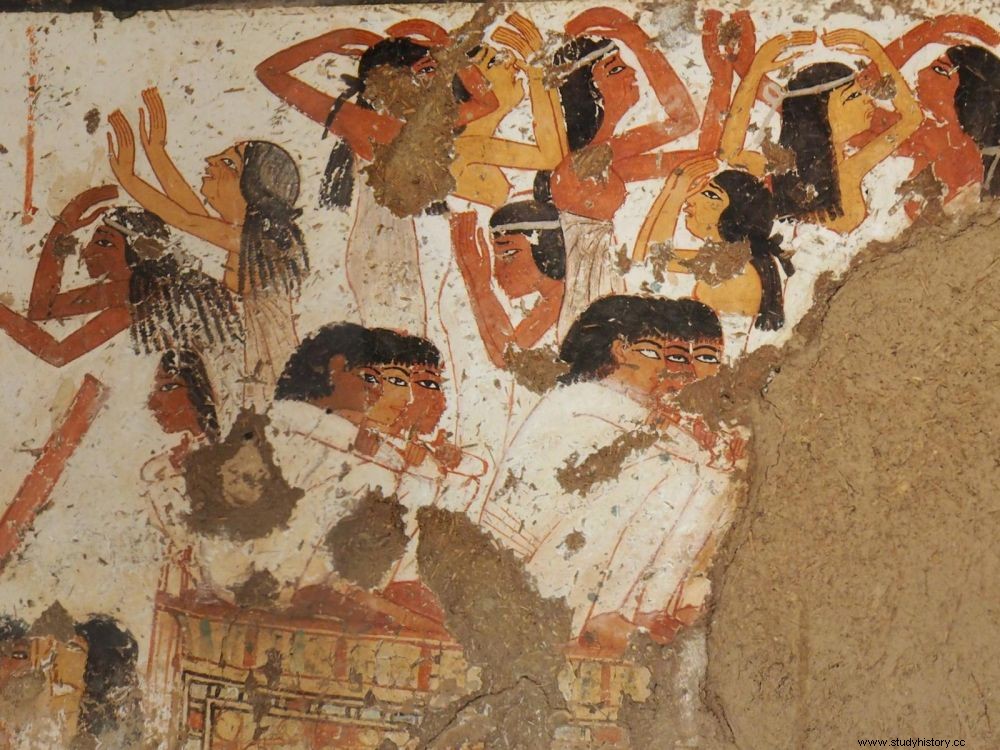
Detail of one of the panels from the tomb of Ipouky and Nebamon:the mourners of the funeral procession
It is a tomb dated to the reign of Amenhotep III which spanned the first half of the 14 th century before our era. This is a remarkable period in the history of Egyptian painting and which saw significant artistic changes. From the first glance, the researchers of the team notice its importance for the study of the practices of painting:all the stages of realization are accessible there because several parts are unfinished. As in the other funerary monuments on the west bank of the Nile in Luxor, the vertical walls are covered with a coating called mouna , prepared by mixing Nile alluvial soil with chopped straw. They are in places just covered with white paint. Elsewhere, broad red lines of stage set-up appear alongside a poignant sketch of a musician playing the lute that has never been colored. Then, background layers, yellow on one wall, elsewhere white. The painters continued their work by applying the colors to arrive at marvelous representations marked by a multitude of details and particularly realistic draping effects.
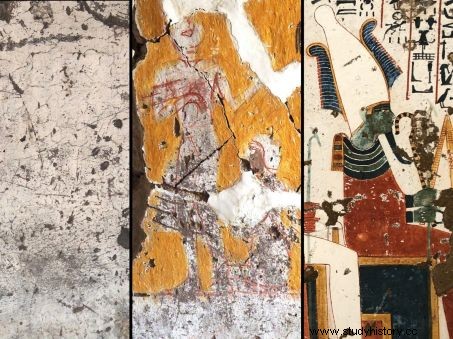
Some details of the painted areas of the tomb of Ipuky and Nebamon:(a) coating of mouna covered with white background, (b) sketch in red line of a musician, (c) representation of Osiris. ©MAFTO-LAMS/CNRS
The team then separates to carry out in parallel the recording of the documentation, the chemical analysis and the meticulous observation of details which underline the work of the artist:raking light to observe the superposition of the layers of color; ultraviolet light to highlight organic materials that may have acted as a varnish; Highly magnifying magnifying glasses and a digital microscope to go even deeper into the subject. As well as the chemical analyzes with the various instruments brought to Egypt by the team.
"From the first glance, we immediately observe the remarkable quality of the paintings"
"One of the main difficulties will be to find how to work together in this tomb because it is small, barely ten square meters" , explains Philippe Walter, researcher at the Molecular and Structural Archeology Laboratory (Sorbonne University-CNRS). "Each study technique has its own constraints and we must not step on our feet. We can define three work areas in this tomb and we will have to constantly fight against the dust that invades our instruments and computers. "
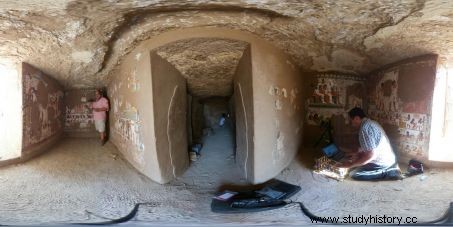
Panoramic view of the activities in the tomb of Ipouky and Nebamon ©MAFTO-LAMS/CNRS
"X-ray fluorescence analysis shows mixtures of pigments"
X-ray fluorescence analysis spectrometry is a technique for determining the chemical composition of paints. Applied to the colors used to represent the skin, it leads to the measurement of iron-based pigments (yellow and red earths) and arsenic-based pigments (sulfides, such as golden yellow orpiment and red realgar) which were mixed. About 3 parts red earth to one part arsenic pigment for the husband; much the same for his wife, but with the yellow pigment varieties. To refine the shade of color, the painter also added a few grains of blue pigment to the mixture. To go further in the identification of pigments, the use of hyperspectral imaging will be necessary.
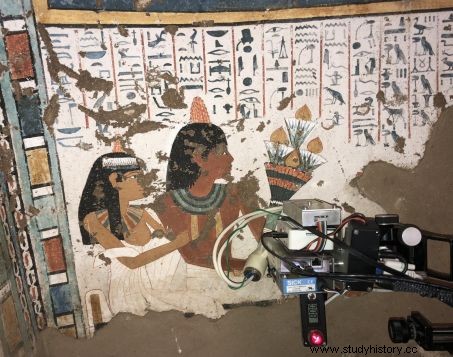
By convention, representations of skin color differ for men and women. X-ray fluorescence analysis. Tomb of Ipouky and Nebamon. ©MAFTO-LAMS/CNRS
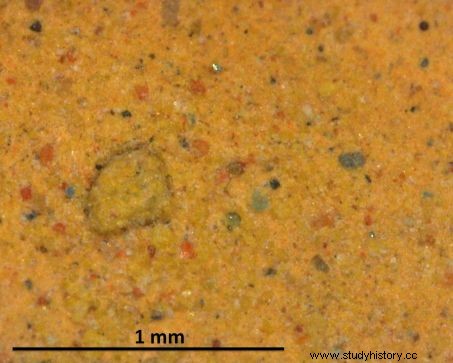
Digital microscope photograph of the woman's complexion:the iron or arsenic pigments have been very finely mixed. A few grains of Egyptian blue pigment have also been added ©ULiege
Notebooks of Egypt, 1st episode:how did the painters of ancient Egypt work?
Notebooks from Egypt, 2nd episode:Discovering the funeral chapel of Nakhtamon.
Notebooks from Egypt, 3rd episode:The pigments of Egyptian painting.
Notebooks from Egypt, 4th episode:The modern documentation of painted walls.
Notebooks from Egypt, 5th episode:Rediscovering the monuments of eternity of Ramses II.
Notebooks from Egypt, 6th episode:Revealing pigments with light:the visible and the invisible.
Notebooks from Egypt, 7th episode:Experiencing research through images.
Notebooks of Egypt, 8th episode:Beginning of the study of the paintings of the tomb of Nebamon and Ipouky.
Notebooks from Egypt, 9th episode:A tomb shared by two artists under Amenhotep III.
Notebooks from Egypt, 10th episode:What the tomb of Amenouahsou, an artist from ancient Egypt, reveals.
Notebooks from Egypt, 11th episode:Strange uses that have been made of Egyptian mummies.
Notebooks from Egypt, 12th episode:"Why don't all the artists come here?"
Notebooks of Egypt, 13th episode:Why did the Egyptians draw the characters in profile?
Notebooks from Egypt, 14th episode:Observing craft practices in Egyptian tombs.
Notebooks from Egypt, 15th episode:About Egyptian perfumes.
Notebooks from Egypt, 16th episode:The colors of the Egyptian palette.
Notebooks of Egypt, 17th episode:The Egyptian language does not know a word to designate "art".
Notebooks of Egypt, 18th episode:The day of a scientific mission in Egypt.
